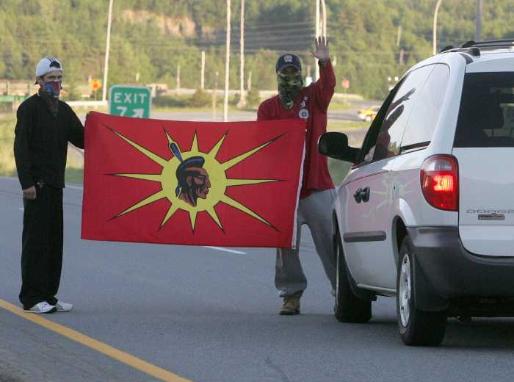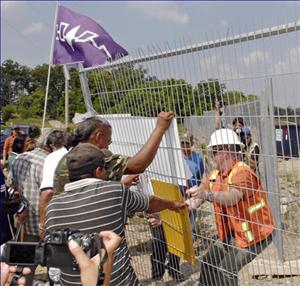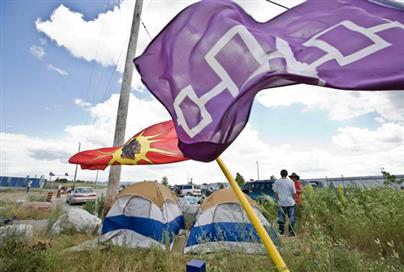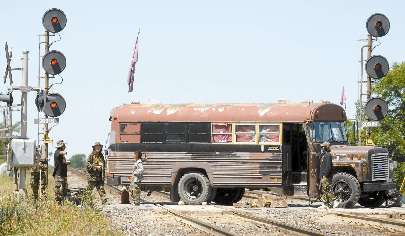
Mohawk protester Brant gets light penalty for blockades
September 29, 2008
—-
Mohawks stop installation of police facility, September 24, 2008
…a group of about 50 people were at the site Tuesday afternoon, vowing to block officials from placing a prefab building they feel the community was not consulted about.
—-
Six Nations group stops work at Eagle Place housing site in Brantford, September 16, 2008
A Six Nations group blocked an attempt to begin work Monday on the site of a new housing development at Erie Avenue and Birkett Lane.
Up to 30 members of the Haudenosaunee Men’s Fire gathered at the site of a 99-home subdivision at about 6 a. m. and didn’t leave until early afternoon.
Their efforts prevented city work crews from beginning work to provide servicing to the site, which is one of five designated no-go zones in bylaws passed by the city and an injunction obtained in Ontario Superior Court prohibiting activities that stop construction work.
“We’re required to be here. It’s our duty to be here, ” said native spokesman Dahwehido:geh, also known as Phillip W. Skye.
“This land is part of the Eagle’s Nest Tract. It has never been surrendered, ceded or given up and it’s our duty to protect it.
“We’re here to make sure that no shovel is put into the ground.”
As he spoke, Skye had a replica of the Two Row Wampum draped over his arm.
He said development of the site would damage the area’s eco-system and he encouraged city officials to move away from developing vacant land.
—-
Arrests spark Six Nations blockade in Caledonia, September 02, 2008
Yesterday morning, Stephen Powless, 43, and two teens were arrested in Brantford for allegedly being on the construction site at the Hampton Inn on Fen Ridge Court, next to the Kingspan Insulated Panels development site from which they are barred.
Police said the trio are under a court order to stay away from the land and were all charged with breach of a court order and mischief.
Clyde Powless, a spokesperson for Six Nations, said the arrests were a “catalyst” for the blockades, but that the community is also frustrated by the slow pace of land claim negations with the provincial and federal governments.
—-
Six Nations people shut down another Brantford development, August 6, 2008
More than 30 Six Nations protesters shut down work on a $500-million industrial and commercial development on Oak Park Road Tuesday morning, saying environmental concerns must be addressed.
—-
Six Nations people take aim at hotel project, July 19, 2008
They set up a large teepee at the edge of the Hampton Inn hotel site on Fen Ridge Court after successfully halting construction of the nearby Kingspan Insulation warehouse and headquarters.
—-
Six Nations people block job site over land dispute, July 14, 2008
BRANTFORD, Ont. — Tensions over native land claims in Southern Ontario flared again Monday morning as a protester blocked a cement truck’s access to a building site and then allegedly assaulted a police officer.
…
The disagreement in Brantford stems from plans to build an insulation factory and headquarters on land that is subject to a long-outstanding native land claim.
…
“We’re continuing to monitor the situation. The underlying issue here is a 200-year-old land claim against the federal government, so the federal government needs to accelerate the negotiations leading to a resolution of this issue,” said Greg Crone, Mr. Bryant’s press secretary.
The Six Nations claim ownership of the area as part of a historical treaty that they allege was not properly honoured. The local government received a temporary injunction in May that prohibits interference with development on the site — owned by Ireland-based Kingspan — and several other nearby properties.
—-

Ignoring injunction, Six Nations people stop work at development sites, July 8, 2008
‘Today is the first day of taking back our territory’
Ignoring injunction, native protesters stop work at development sites
Natives ignored a court injunction Monday by marching onto development sites across the city.
Construction was halted at five projects as about 150 native protesters burst onto dusty work sites and ordered employees to shut down equipment.
…
When the protesters moved along Fen Ridge Court to the construction site for Kingspan Insulation’s new headquarters and industrial plant, they found all the workers, their cars and equipment were behind a locked eight-foot metal fence.
…
When the worker refused, saying the land belonged to the developers, several natives simply lifted a portion of the metal fence out of its moorings and swung it out like a garden gate. When it toppled, the natives walked over it and swarmed over the enormous property, ranging out to where huge earth-movers were operating and insisting the work stop.
At each site, the protesters waited patiently for the workers to shut down equipment, pack up their tools and move out of the area, often waving goodbye.
—-

Solidarity with Tyendinaga and Six Nations, May 1, 2008
Ontario Provincial Police (OPP) attacked the Mohawk people at the Tyendinaga/Deseronto reclaimed quarry on Friday, April 25, 2008, arresting as many as 10 people and pointing guns. Solidarity blockades, actions and demonstrations took place in Six Nations/Caledonia, Akwesasne, Kahnawake, Guelph, Ottawa, Toronto and Vancouver over the following four days. On April 26, the OPP threatened to remove by force the blockade of the Highway 6 bypass at Six Nations/Caledonia, but reinforcements that arrived from the reserve convinced the cops otherwise. The OPP backed-off from the Tyendinaga/Deseronto quarry on April 29 and the blockade of the Highway 6 bypass at Six Nations/Caledonia was brought down.

—-
Show of OPP force ends native blockade, April 23, 2008
Native protesters who orchestrated a blockade of a major portion of this town earlier this week dispersed Tuesday morning when confronted by a phalanx of OPP officers.
As well, the developer who sparked the incident pledged Tuesday to stay away from developing any portion of lands involved in the native claim known as the Culbertson Tract.
…
Protesters are still occupying portions of the disputed land development, most notably at the nearby Thurlow Aggregates quarry along Deseronto Road, which they have occupied since last March.
—-
Development must stop on our land, October 20, 2007
Members of Six Nations staged a 12-hour protest Friday at Henry Street and Wayne Gretzky Parkway, halting construction of a $40-million commercial development.
About a dozen natives arrived at 6:30 a.m., blocking the site entrance to stop workers from driving in. They erected Six Nations flags and signs that read “Six Nations Land” and “Your Lease is Up.” City police monitored the site during the protest, which ended at about 6 p.m.
The First Gulf development was also the site of a Six Nations protest in March, when natives asked for a delay in work until the company met with the Six Nations Confederacy.
—-
OPP arrest nine at Caledonia re-occupation, September 20, 2007
The last pocket of native protesters was cleared yesterday from a residential construction site where a house builder was severely beaten last week.
With neighbours watching and cheering from their back yards, about 50 OPP officers in riot gear marched in and arrested nine men and women who had defied their native elders by refusing to leave the Stirling Street development.
The operation went off without any major hitches and natives watching from the sidelines made no attempt to assist the protesters. It was in marked contrast to the abortive OPP raid at Douglas Creek Estates on April 20, 2006, when protesters with clubs and crude weapons chased off a heavily- armed police tactical team, injuring several officers.
…
For the first time since last Thursday, when all construction had stopped, other tradespeople had started trickling back in as well.
Even with the large police presence, Gualtieri said his bricklayers were apprehensive and were working much faster than usual.
They had noticed a handful of native protesters poking around a large mound of dirt on the east side of the development where there was a large banner accusing Canada of genocide against aboriginal people.
In the early afternoon, police started setting up checkpoints and roadblocks around the subdivision and told workers to leave for their own safety.
By about 2 p.m., a large number of vans and other specialized police vehicles, plus two canine units, rolled onto the site.
By about 2:30 p.m., there were about 100 officers on the site, including members of Hamilton police, and a large contingent of tactical officers in riot gear.
Gualtieri said he was impressed by the military precision of the operation as he watched the tactical officers suiting up and preparing to confront the protesters.
He added it was empowering to watch the baton-wielding officers tapping their shields in unison as they closed in on the protesters, who had refused to budge when a uniformed officer had asked them to leave a few minutes earlier.
—-
Native protest stalls Brantford project, Sep 5, 2007
A small city developer fears he has lost his financing, tradespeople and suppliers for a $1.2-million, four-duplex development native protesters shut down yesterday.
Mayberry Homes owner Mike Quattrociocchi, a former Brantford city councillor, said several protesters climbed into a foundation hole being dug and sat down in front of a backhoe, effectively stopping work at 11 a.m.
They argued the land is the subject of a land claim.
====

Follow the links above for more info on each protest, and more.
For other indigenous resistance in Canada during 2007, see http://earthfirst.org.uk/actionreports/node/22099
====
Background 2005 article on indigenous resistance: Mining: Stealing the Land from Under Us
Background –
In 1995, Tyendinaga filed a specific claim for the Culberston Tract, a 923-acre parcel near their territory. In 2003, as part of the land claims negotiations, the Federal Government acknowledged that the Culbertson Tract had never been surrendered, but rather than return the land, wanted Tyendinaga to take a cash buy-out.
